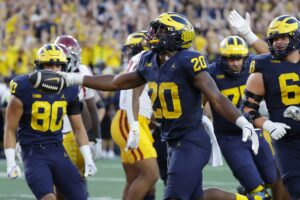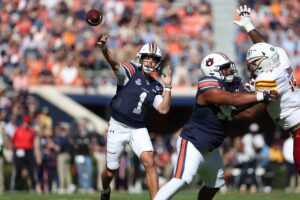For the loser now / Will be later to win / For the times they are a-changin’.
Bob Dylan, “The Times They Are A-Changin'”
100 years ago, World War I and a Spanish flu pandemic shortened college football’s 1918 season. Pop Warner and John Heisman reigned as the game’s best coaches. The rapidly shifting landscape of college football in the decade prior had settled. And Warner and Heisman shared significant responsibility for what the game had become.
When these two legends met in the middle of the season at Forbes Field, writers waxed poetic about the matchup. Warner coached the Pitt Panthers, and Heisman coached visiting Georgia Tech. Despite the hype, Pitt dominated the game, winning 32-0. Pitt was ultimately crowned national champions that season (at least by some).
In the decade before this clash of legends, Warner and Heisman both made significant impacts on the game. Warner developed the precursors to the spread and shotgun formations, the three-point stance, and the body blocking technique. All of these advancements widely impact the game today.
Heisman, on the other hand, advocated for substantial rule changes designed to open up the game and protect players. In fact, he and Theodore Roosevelt significantly influenced the creation of the NCAA with the primary goal of protecting player safety. Heisman is also considered the father of the forward pass, which continues to be revolutionized.
In 1918, though, the open offense and the NCAA were brand new, their influences still unsettled. The game had changed significantly in the ten years prior. And a lot has certainly changed in the hundred years since.
Conference Realignment and the College Football Playoff
The game today has also changed significantly in the past decade. In 2010, the first pieces of conference realignment fell when Big 12 members Nebraska and Colorado announced their intention to join the Big Ten and Pac-10 conferences respectively. Since then, the former Big East collapsed, and six “major” conferences narrowed to the “Power Five” conferences.
The realignment was driven by money, particularly the reshuffling of long-term TV deals. The growth in revenue since that time speaks for itself. In 2010, the average major conference team earned around $15 million from its conference. This year, the Power Five conferences paid their member schools, on average, between $26.6 million (in the ACC) and $41 million (in the SEC).
Revenue also increased significantly when the NCAA implemented the current playoff system. Under the old BCS system, the major conferences received close to $28 million each as a base payment. Under the current playoff system, each of the Power Five conferences receives $50 million each as a base payment. Included bonuses earned for meeting certain selection criteria, the average payout per conference has increased by over $25 million in the current system. Clearly, money in college football has grown, and rapidly (despite the nationwide attendance problem that we discussed here).
Student-Athletes Advocate for Their Rights
As the money grew, so, too, did student-athlete discontent. In particular, a class of former student-athletes sued the NCAA and EA Sports for using their names and likenesses without compensation. This saga, which lasted from 2009 through 2016, highlighted several student-athlete issues revolving around one common theme: how to improve student-athlete quality of life.
Observers and participants alike posed hard questions. Was a scholarship sufficient to compensate student-athletes for their contributions? What expectations could schools fairly have of their student-athletes in exchange for their scholarships? If big money led to frequent reshuffling of coaching staffs, was it fair to hold players to multiple years of loyalty to their schools? Was the same fair in light of the ability of a school to revoke a players’ scholarship each year? Articles with proposed resolutions circulated daily. Stipends above and beyond the cost of room, board, and tuition, scholarship guarantees, and relaxing transfer rules were all fair game.
Student-athletes advocated openly for their own interests. High-profile players started skipping bowl games to prevent injury and prepare for NFL combines. Leonard Fournette and Christian McCaffrey were the first. This year, Nick Bosa even decided to forgo an entire season to recover from injury and avoid risking further injury prior to the draft season. Fans, on the whole, seem to hate the trend, but players have gained more than they have lost, at least so far.
First Round of Rules Benefit Student-Athletes
In response to these pressures, the NCAA made several changes over the past few years. In 2015, for example, the Power Five schools plus Notre Dame agreed to a rule prohibiting athletic departments from pulling student-athletes scholarships for reasons related to athletic performance. The change was seen to protect the student-athlete. In exchange, the student-athlete had to sign a National Letter of Intent and scholarship agreement.
At the same time, the NCAA also approved stipends above the value of scholarships to allow schools to pay student-athletes the “full cost of attendance.” These stipends range from approximately $2,000.00 to $5,000.00 and amounts to an “extra” payment from the school. Again, this rule was seen as a tool to promote fairness to the student-athlete (despite some argument that both rules were actually aimed at increasing Power Five schools’ competitive advantage).
Second Round of Rules Open the Transfer Market
Most recently, the NCAA instituted a pair of changes impacting the transfer market. First, the NCAA passed a change allowing players to play in up to four games and retain a red-shirt. In other words, if a student-athlete plays in only four games as a true freshman, that student-athlete would remain a redshirt freshman his sophomore year.
The NCAA also passed a rule eliminating the “permission-to-contact” process. In lieu of the old process, a student-athlete seeking to transfer will notify his current school of his intention, and the current school must then place the student-athlete’s name in a national transfer database. Other coaches are then free to contact the student-athlete. The athlete’s current school is effectively unable to prohibit or limit transfer options.
While the first rule was intended to promote and incentivize increased playing time for younger players, the rule has been viewed by many as the beginning of “free agency” in college football. The combination of rules allows a player to showcase his ability in a handful of games and then notify his coaching staff of an intention to transfer before losing eligibility. This choice, in other words, belongs to the player now.
Importantly, the NCAA has not changed the residency rule for transfers. As a result, unless a player has graduated from his prior school, a player must sit out for one season at his new school before the athlete can compete for the new school. The athlete may request a waiver of the residency requirement. The rules surrounding such waiver are unclear, however, and the NCAA retains discretion.
Shifting Landscape of College Football: The Impact
Fans, coaches, and writers frequently debate the merits of the new transfer rules. But we often forget to consider that the NCAA as a whole was created to look out for the players. Way back when Roosevelt and Heisman were its stewards, the NCAA’s original mission was to protect player safety and quality of life. The new rules certainly improve player quality of life.
Many have questioned the impact this might have on the loyalty, teamwork, and discipline that has defined college football for years. While fair, the question loses appeal as revenues dominate more aspects of the game. Why should college football programs be able to commoditize the student-athletes from whom they generate, in some instances, hundreds of millions of dollars per year without the athletes having relatively minor freedom to make transfer decisions?
Transfers Already Mounting
The rule changes have already impacted the game. Auburn, for example, has already lost a number of quality players to the new transfer market. The biggest name there is top-50 recruit Nate Craig-Myers. About the news, Gus Malzahn said, “This is a new day, and I think you’ll see more and more of that (across college football).” Auburn also loses tight end Jalen Harris to transfer. Jack Tuttle, a four-star quarterback, recently declared his intent to transfer out of Utah. And Oregon running back Taj Griffin will also transfer before next season.
Several high-profile graduate transfers have joined the market, too. The biggest splash here was Kelly Bryant, who announced his intent to transfer after Clemson Head Coach Dabo Swinney replaced Bryant as the starter. Oklahoma State wide receiver Jalen McCleskey is also transferring. Head Coach Mike Gundy openly lamented, “[W]e live in a world where things like that happen now. But if they come to you and say, ‘I’m not getting the ball enough and I feel like I need to be somewhere that allows that to happen,’ then you have to give them that opportunity.” Wide receiver Jonathan Nance is also transferring from Arkansas.
Expect Numbers to Grow
As players and their families grow more comfortable with this process, fans and teams should expect this number to increase. Team strategies both to retain players and to recruit transfers will grow, and this will indeed become a bona fide recruiting pool.
At least one issue that schools will need to assess is how the transfer market will impact scholarship limits. As it stands now, a school can only sign 25 new scholarship players per season, including incoming transfers. Once signed, a player counts towards that season’s hard cap. Thus, if a school sees several players elect to transfer out each season, then that school will start losing ground against its total scholarship limit of 85. It will then be harder to make up for such attrition. Finally, most schools will look to keep a handful of scholarships open for potential incoming transfers. But hard decisions will follow absent rule changes in this realm.
More immediately, however, there are two open questions. First, will student-athletes seeking to extend their final year of eligibility misjudge their ability to graduate? Because of the one-year residency requirement, a player could theoretically waste his final year of eligibility if he does not graduate as expected. Second, the NCAA has been inconsistent, at best, in its decisions to grant waivers of the residency requirement. If the NCAA trends more liberally in granting such applications, then the number of transfers could skyrocket.
Regardless of how one feels about the shifting sands, it is clear that the ride is just beginning.






